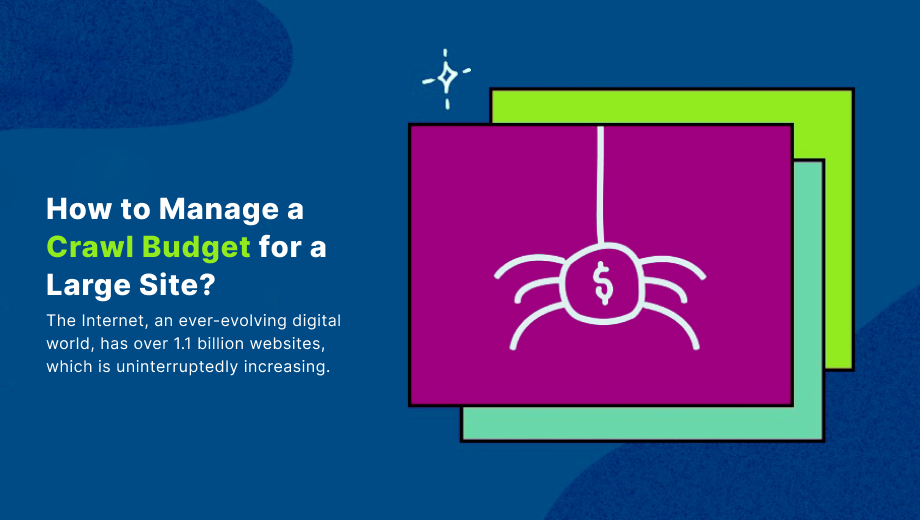How to Manage a Crawl Budget for a Large Site?
 31 July 2023
31 July 2023
 31 July 2023
31 July 2023
The Internet, an ever-evolving digital world, has over 1.1 billion websites, which is uninterruptedly increasing.
Does the staggering scale of this figure trigger curiosity? Conscientiously, you may wonder how Google, with all its wealth, resources, and data centers, could index every page on the internet.
But the truth is twofold. Despite its vast powers, Google neither has the ability nor the desire to crawl the entire web.

The crawl budget is the sum of the time & resources that Googlebot devotes to crawling a domain's web pages.
Therefore, optimizing your website using the best search engine optimization services, like Google’s crawling services, is crucial. This will further allow the search engine to identify & index your material quickly. As a result, it increases traffic & visibility to your site.
If you possess a large website featuring millions of pages, managing your crawl budget judiciously becomes crucial. This careful handling ensures that Google can appropriately crawl your most important pages and thoroughly analyze your content.
According to Google:
“If your site does not have a large number of pages that change rapidly, or if your pages seem to be crawled the same day they are published, keeping your sitemap up to date and checking your index coverage regularly is enough. Google also states that each page must be reviewed, consolidated, and assessed to determine where it will be indexed after it has crawled. The crawl budget is determined by two main elements: crawl capacity limit and crawl demand.”
The number of times Google wants to crawl your website is known as the crawl demand. So, more popular pages, such as a well-read CNN item or pages that undergo substantial modifications, will be crawled more frequently.
“Googlebot wants to crawl your site without overwhelming your servers. To prevent this, Googlebot calculates a crawl capacity limit, the maximum number of simultaneous parallel connections that Googlebot can use to crawl a site, and the time delay between fetches. Using crawl capacity and demand, Google defines a site’s crawl budget as the URLs that Googlebot can and wants to crawl. Even if the crawl capacity limit is not reached, if crawl demand is low, Googlebot will crawl your site less.”
Here are the top 5 recommendations for managing the crawl budgets. These recommendations benefit medium to large websites hosting 10,000 to 500,000 URLs.
Decide which pages to crawl are crucial and which to ignore (and those Google will visit less frequently). Well, the first step involves establishing a comprehensive analysis. For this, you can discern which pages on your site merit crawling and which don’t. Consequently, you can exclude the latter from the crawling process.
For instance, Macys.com has nearly 2 million indexed pages.
One way to manage the crawl budget is by directing Google not to crawl certain pages of your website. You can further accomplish this by restricting Googlebot’s ability to access those URLs via the robots.txt file.
While Google does not inflict penalties for duplicate content, you should still prioritize originality. Ensuring that your content meets the end user’s needs and is both relevant & informative is crucial for Googlebot’s optimal operation. So, verify the use of the robots.txt file. Google advised against using no index because it will continue to request but then drop.
Google advises enterprise-level websites with millions of pages to use robots.txt to prevent unimportant URLs from being indexed. Additionally, ensure that Googlebot and other search engines can effectively crawl your essential pages. This should include directories that contain your most valuable content and the pages that drive your venue.
If you can, limit the number of redirects you use. Overused redirects and loops can confuse Google and lower your crawl limit. According to Google, lengthy redirect chains may hinder crawling.
Utilizing HTML enhances the likelihood that a search engine crawler will visit your page. While Google’s search engine crawlers have notably improved their ability to index & crawl JavaScript, this advancement isn’t universal. Crawlers from other search engines are often less sophisticated and can struggle with comprehending languages beyond HTML.
Due to their massive size & complexity, huge sites require crawl budget optimization. Hiring the best search engine optimization services will help you achieve this task.
Search engine crawlers struggle to efficiently and effectively crawl and index the site's material due to the site's large number of pages and dynamic content.
Site owners can prioritize the crawling & indexing of crucial & updated pages by managing their crawl budget, ensuring that search engines use their resources efficiently.
With tactics like bettering site layout, controlling URL parameters, defining crawl priority, and removing duplicate material, huge websites can benefit from greater search engine exposure, a better user experience, and a rise in organic traffic.